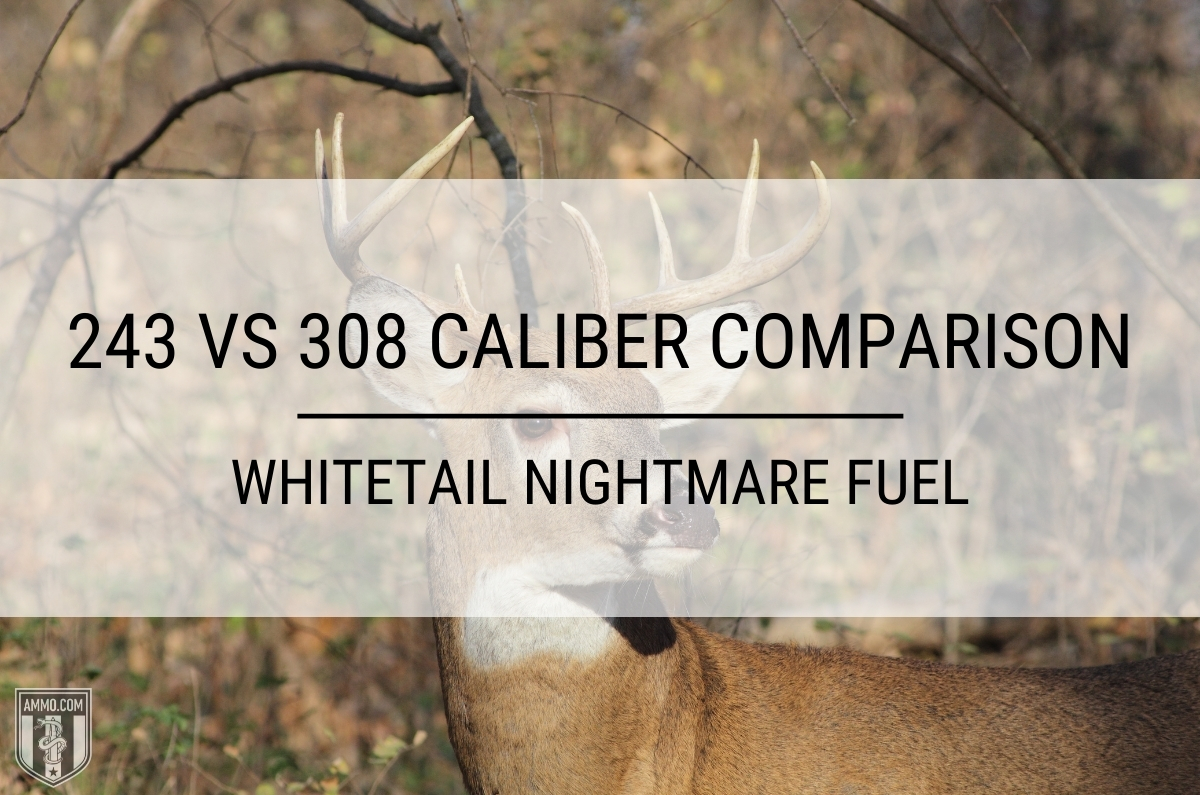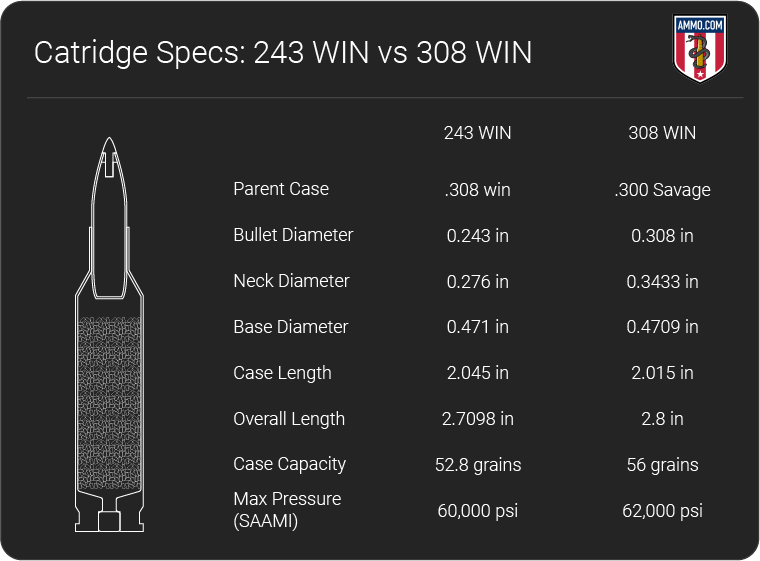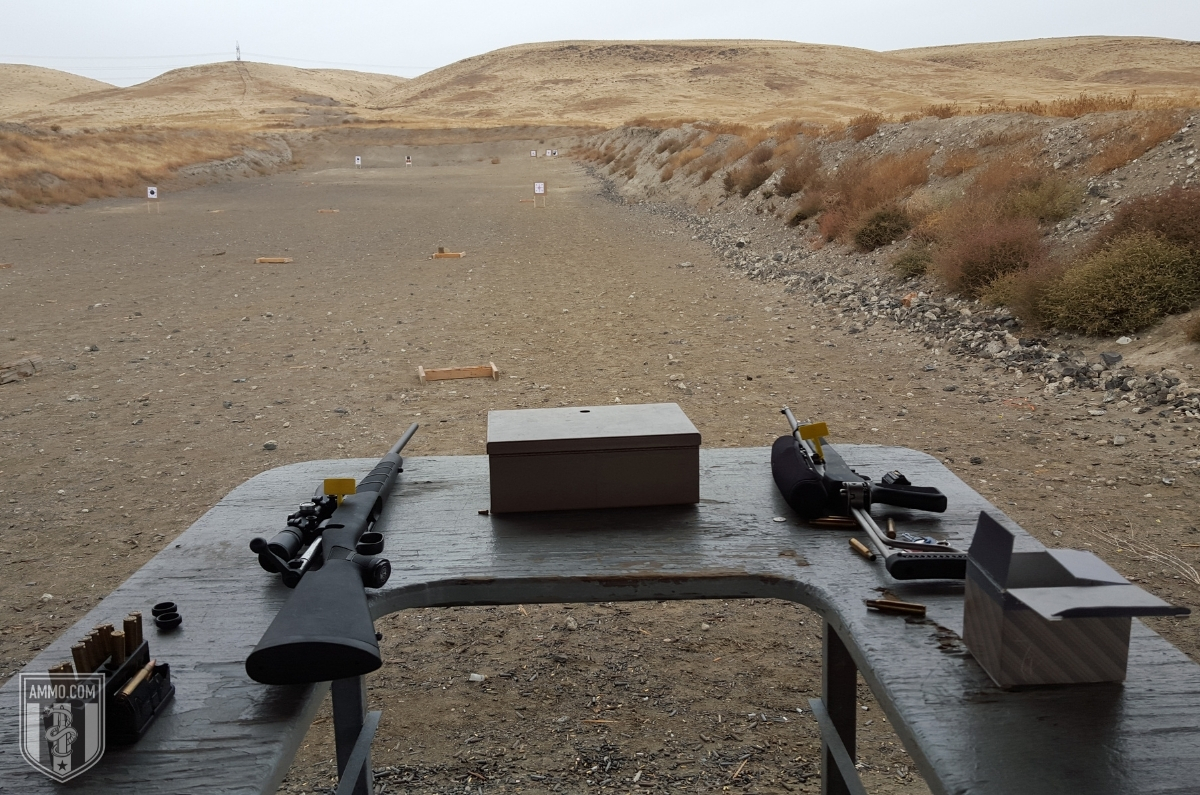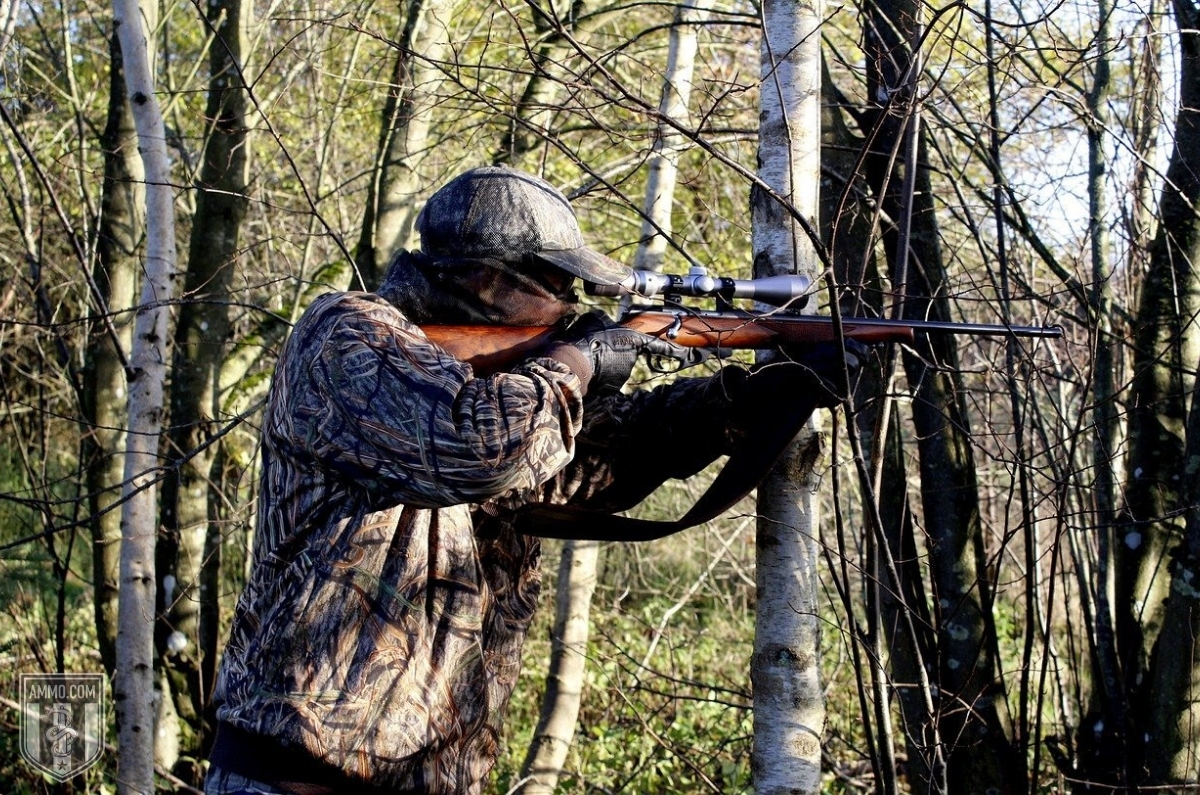243 vs 308 Caliber Comparison: Whitetail Nightmare Fuel
 When it comes to medium to large game hunting, two rifle cartridges stand out from the rest, 308 Winchester and 243 Winchester.
When it comes to medium to large game hunting, two rifle cartridges stand out from the rest, 308 Winchester and 243 Winchester.
These two rifle cartridges offer a wide variety of ammo to meet your needs for varmint hunting. From Pronghorn to prairie dogs to antelope to Whitetail deer, no varmint is safe from the 243 Winchester or the 308.
But which cartridge will suit your needs best for your next hunting rifle?
In this article, we will take a detailed look into the pros and cons of each rifle cartridge to help you pick the best cartridge for your needs.
Time to break out the camo ghillie suit, the scent eliminator spray, and tree stand because we are putting the 234 Win and the 308 to the test in the field!
243 vs 308: What's the difference between 243 and 308?
If you’d like to poke the bear on any online hunting forum, all that’s needed is to proclaim that “243 Win is best!” Or conversely, “308 Win is best!” And then sit back and watch the fireworks.
There’s no denying that both cartridges are excellent at effectively and ethically harvesting medium to large game animals, but which one truly is better?
Both cartridges are effective at long range and have enough muzzle energy to take down a mule deer at 400 yards.
Let’s take a look at the origins of each cartridge and then we can take a look at the pros and cons.
308 Winchester: An American Military Masterpiece
The 308 Win was introduced in 1952 by Winchester in its iconic Model 70 bolt action and Model 88 lever action rifles. The cartridge was originally developed by the US Military to replace the aging 30-06 Springfield that had served through two World Wars and Korea.
Though the 30-06 had served valiantly, the US Military wanted a more modern cartridge that would be suitable for use in a magazine fed, select-fire battle rifle that was compatible with a short action and was lighter than the aging 30-06 Springfield. The 7.62x51 mm NATO round was developed to meet these needs and the M14 was adopted as the United States’ new battle rifle. The M14 and 7.62 NATO served briefly in Vietnam before being replaced by the M16 and the newer 5.56x45 mm NATO (civilian designation: 223 Rem).
Winchester picked up the 7.62 NATO and quickly adapted it for civilian sale, rebranding in the 308 Winchester. Seeing the wide-spread success of Winchester's new cartridge, other manufacturers were quick to add a 308 Win offering in their rifle lines (such as the Remington 700 and Weatherby Vanguard).
And the rest, as they say, is history!
Since its introduction, the 308 Win has become the quintessential hunting cartridge, with enough stopping power and range to harvest almost any large game animal in North America. With proper shot placement, a 308 can even take down the great bears (but I think I’ll take a 300 Win Mag or 338 Lapua Magnum if I’m going to the Kodiak Archipelago!)
Furthermore, the 308 Win has been the long range ammo of choice for military snipers and law enforcement sharp shooters for well over 60 years (until recently when the 300 Win Mag and the 6.5 Creedmoor started gaining popularity in these circles).
243 Winchester: 308’s Little Brother
The 243 Winchester was introduced to the civilian market in 1955, just 3 years after the 308 came to market. The parent case for the 243 Win is actually the 308 Winchester that has been necked down to accept a .243” diameter bullet.
The 243 Winchester ammo became extremely popular with varmint hunters who were looking for a cartridge with a flat trajectory and less felt recoil compared to their 308 hunting rifles. They also wanted enough stopping power to take down Whitetail deer, Pronghorn, Mule deer, and Antelope.
The 243 Win received massive commercial success in a rather short timeframe due to several factors.
The first was an expose done in Field and Stream by editor Warren Page, who gushed about his love affair with the 243 in his columns.
The second was actually a massive faux pas by Remington, who released their new cartridge, the .244 Rem, the same year. The 244 Remington was developed by necking down a .257 Roberts case (which itself was a necked down 7x57mm Mauser case) to accept a 243-caliber bullet.
The mistake that Remington made was not in the design of the 244 Rem cartridge but instead the choice of barrel twist rate.
Remington’s initial design called for a 1:12” rifling twist rate for the new 244 Rem cartridge. Unfortunately, the slower twist rate was unable to stabilize the longer and heavier 100-grain bullets (which are preferred for deer hunting).
A bullet that is not rotating fast enough before exiting the barrel can have a propensity to tumble in flight and cause “keyholing” (this is when the bullet enters the target sideways, and the resulting hole looks like a keyhole).
A destabilized bullet massively reduces accuracy and lethality, making the cartridge essentially unusable for hunters. Luckily for Winchester, their rifles chambered for 243 Win all had 1:9” twist rate barrels, which had zero issues stabilizing a 100-grain bullet. This made the 243 Winchester the superior choice over the Remington offering.
243 vs 308 Win Caliber Comparison
It’s time to start our comparison of these two iconic hunting cartridges. Let’s start by taking a look at the specs for each.

As we mention previously, the parent case for the 243 Winchester is the 308 Winchester. To create the 243 Win, the 308’s neck diameter was reduced to accept a 243-caliber bullet, and a little material was taken off the top of the cartridge. Otherwise, the cartridges have extremely similar dimensions.
The case capacity of each is almost identical (56 gr vs 54 gr H2O) which allows for lighter .243 bullets to be fired at an extremely high muzzle velocity. Furthermore, the case length is almost exactly identical within a few hundredths of an inch.
However, please note that the maximum allowable pressure for the 243 Win is a full 2,000 psi lower than the 308 Winchester. This won’t matter if you only shoot factory loads, but if you reload and like to push the envelope, make sure you’re watching for pressure signs (flattened primers, case head extrusion, etc.) if you plan to load your 243s hot.
Recoil
One of the massive advantages that the 243 Winchester offers shooters is extremely low felt recoil. Shoulder fatigue and recoil anticipation are real problems when it comes to downrange accuracy.
When compared to the 308 Winchester, the 243 has about 50% less felt recoil. Average recoil for a 308 comes in around 22 ft-lb of force compared to about 11 ft-lb of force for the 243 Win.
That’s HUGE!
Now I know that you might be thinking to yourself, “Oh come on Chris, the 308 recoil isn’t that bad!” And you’re mostly right.
For a 30-caliber, the 308 is less punishing on the should when compared to something like a 300 Win Mag or even a 30-06 Springfield.
The fact of the matter is that less recoil will promote enhanced accuracy with most shooters.
The biggest cause of pulled shots at the range is trigger jerk and this is most often caused by recoil anticipation. This happens when the shooter actively pulls the trigger because they are expecting the recoil, which dives the barrel of the rifle down. This pushes the shot low and can let that trophy Pronghorn bound away unscathed (and probably laughing at you in the process!)
Accuracy
Both the 243 Win and 308 Win are extremely accurate rifle cartridges. The 308 Winchester was the round of choice for sharpshooters in both military and law enforcement circles for well over 60 years (though some departments are switching to the 6.5 Creedmoor or the 300 Win Mag).
I will give a slight accuracy advantage to the 243 Win here only due to its flatter trajectory and lower recoil. Shooters will often report that they just “shoot their 243 better” and this is often the reason why.
However, all things being equal with proper shooting technique and trigger control, there should be no discernable difference in accuracy between the 243 and the 308.
Ballistics Chart
Now we get to the fun part! Or the eye-rolling part if you think ballistics tables are akin to differential calculus.
Regardless of which camp you find yourself in, our team here at Ammo.com has put together some deer-slaying 243 and 308 ballistics charts for you to compare and contrast the numbers on these rifle cartridges.
243 Ballistics
Note: This information comes from the manufacturer and is for informational purposes only. The actual ballistics obtained with your firearm can vary considerably from the advertised ballistics. Also, ballistics can vary from lot to lot with the same brand and type load.
| 243 Bullet WEIGHT | Muzzle VELOCITY (fps) | Muzzle ENERGY (ft. lbs.) | TRAJECTORY (in.) | |||||||||||
|---|---|---|---|---|---|---|---|---|---|---|---|---|---|---|
| Muzzle | 100 yds. | 200 yds. | 300 yds. | 400 yds. | Muzzle | 100 yds. | 200 yds. | 300 yds. | 400 yds. | 100 yds. | 200 yds. | 300 yds. | 400 yds. | |
| 55 Grain | 4025 | 3597 | 3209 | 2853 | 2525 | 1978 | 1579 | 1257 | 994 | 779 | 0.6 | 0 | -4 | -12.2 |
| 55 Grain WSSM | 4060 | 3628 | 3237 | 2880 | 2550 | 2013 | 1607 | 1280 | 1013 | 794 | 0.6 | 0 | -3.9 | -12 |
| 58 Grain | 3925 | 3465 | 3052 | 2676 | 2330 | 1984 | 1546 | 1200 | 922 | 699 | 0.7 | 0 | -4.4 | -13.8 |
| 60 Grain | 3600 | 3110 | 2660 | 2260 | 1890 | 1725 | 1285 | 945 | 680 | 475 | 2 | 1.8 | -3.3 | -15.5 |
| 70 Grain | 3400 | 3020 | 2672 | 2350 | 2050 | 1797 | 1418 | 1110 | 858 | 653 | 0 | -2.5 | -9.7 | n/a |
| 70 Grain | 3400 | 3040 | 2700 | 2390 | 2100 | 1795 | 1435 | 1135 | 890 | 685 | 1.1 | 0 | -5.9 | -18 |
| 75 Grain | 3350 | 2955 | 2593 | 2259 | 1951 | 1993 | 1551 | 1194 | 906 | 676 | 2 | 0.9 | -5 | -19 |
| 80 Grain | 3350 | 2955 | 2593 | 2259 | 1951 | 1993 | 1551 | 1194 | 906 | 676 | 2 | 0.9 | -5 | -19 |
| 80 Grain | 3425 | 3081 | 2763 | 2468 | 2190 | 2984 | 1686 | 1357 | 1082 | 852 | 1.1 | 0 | -5.7 | -17.1 |
| 80 Grain Superformance | 3425 | 3080 | 2760 | 2463 | 2184 | 2083 | 1684 | 1353 | 1077 | 847 | 1.1 | 0 | -5.7 | -17.1 |
| 85 Grain | 3320 | 3070 | 2830 | 2600 | 2380 | 2080 | 1770 | 1510 | 1280 | 1070 | 2 | 1.2 | -4 | -14 |
| 87 Grain | 2800 | 2574 | 2359 | 2155 | 1961 | 1514 | 1280 | 1075 | 897 | 743 | 1.9 | 0 | -8.1 | -23.8 |
| 90 Grain | 3120 | 2871 | 2635 | 2411 | 2199 | 1946 | 1647 | 1388 | 1162 | 966 | 1.4 | 0 | -6.4 | -18.8 |
| 95 Grain | 3185 | 2908 | 2649 | 2404 | 2172 | 2140 | 1784 | 1480 | 1219 | 995 | 1.3 | 0 | -6.3 | -18.6 |
| 95 Grain WSSM | 3250 | 3000 | 2763 | 2538 | 2325 | 2258 | 1898 | 1610 | 1359 | 1140 | 1.2 | 0 | -5.7 | -16.9 |
| 100 Grain | 2960 | 2697 | 2449 | 2215 | 1993 | 1945 | 1615 | 1332 | 1089 | 882 | 2.5 | 1.2 | -6 | -20 |
| 100 Grain Light Magnum | 3100 | 2839 | 2592 | 2358 | 2138 | 2133 | 1790 | 1491 | 1235 | 1014 | 1.5 | 0 | -6.8 | -19.8 |
| 100 Grain WSSM | 3110 | 2838 | 2583 | 2341 | 2112 | 2147 | 1789 | 1481 | 1217 | 991 | 1.4 | 0 | -6.6 | -19.7 |
| 105 Grain | 2920 | 2689 | 2470 | 2261 | 2062 | 1988 | 1686 | 1422 | 1192 | 992 | 2.5 | 1.6 | -5 | -18.4 |
308 Ballistics
Note: This information comes from the manufacturer and is for informational purposes only. The actual ballistics obtained with your firearm can vary considerably from the advertised ballistics. Also, ballistics can vary from lot to lot with the same brand and type load.
| 308 Winchester Bullet WEIGHT | Muzzle VELOCITY (fps) | Muzzle ENERGY (ft. lbs.) | TRAJECTORY (in.) | |||||||||||
|---|---|---|---|---|---|---|---|---|---|---|---|---|---|---|
| Muzzle | 100 yds. | 200 yds. | 300 yds. | 400 yds. | Muzzle | 100 yds. | 200 yds. | 300 yds. | 400 yds. | 100 yds. | 200 yds. | 300 yds. | 400 yds. | |
| 55 Grain | 3770 | 3215 | 2726 | 2286 | 1888 | 1735 | 1262 | 907 | 638 | 435 | -2 | 1.4 | -3.8 | -15.8 |
| 110 Grain | 3165 | 2830 | 2520 | 2230 | 1960 | 2447 | 1956 | 1551 | 1215 | 938 | 1.4 | 0 | -6.9 | -20.9 |
| 120 Grain | 2850 | 2497 | 2171 | n/a | n/a | 2164 | 1662 | 1256 | n/a | n/a | 0 | -2.8 | n/a | n/a |
| 150 Grain | 2820 | 2533 | 2263 | 2009 | 1774 | 2648 | 2137 | 1705 | 1344 | 1048 | 2.5 | 0.4 | -8.5 | -26.1 |
| 150 Grain Superformance | 3000 | 2772 | 2555 | 2348 | 1962 | 2997 | 2558 | 2173 | 1836 | 1540 | 1.5 | 0 | -6.9 | -20 |
| 155 Grain | 2775 | 2553 | 2342 | 2141 | 1950 | 2650 | 2243 | 1887 | 1577 | 1308 | 1.9 | 0 | -8.3 | -24.2 |
| 155 Grain | 2850 | 2640 | 2438 | 2247 | 2064 | 2795 | 2398 | 2047 | 1737 | 1466 | 1.8 | 0 | -7.5 | -22.1 |
| 165 Grain | 2700 | 2440 | 2194 | 1963 | 1748 | 2670 | 2180 | 1763 | 1411 | 1199 | 2.5 | 0 | -9.7 | -28.5 |
| 168 Grain | 2680 | 2493 | 2314 | 2143 | 1979 | 2678 | 2318 | 1998 | 1713 | 1460 | 2.5 | 0 | -8.9 | -25.3 |
| 168 Grain Super Match | 2870 | 2647 | 2462 | 2284 | 2114 | 3008 | 2613 | 2261 | 1946 | 1667 | 1.7 | 0 | -7.5 | -21.6 |
| 170 Grain | 2000 | 1740 | 1510 | n/a | n/a | 1510 | 1145 | 860 | n/a | n/a | 0 | 0 | 0 | 0 |
| 178 Grain | 2620 | 2415 | 2220 | 2034 | 1857 | 2713 | 2306 | 1948 | 1635 | 1363 | 2.5 | 0 | -9.6 | -27.6 |
| 178 Grain Super Match | 2780 | 2609 | 2444 | 2285 | 2132 | 3054 | 2690 | 2361 | 2064 | 1797 | 1.8 | 0 | -7.6 | -21.9 |
| 180 Grain | 2620 | 2393 | 2178 | 1974 | 1782 | 2743 | 2288 | 1896 | 1557 | 1269 | 2.5 | -0.2 | -10.2 | -28.5 |
Let’s break down each of these ballistics categories and talk about why they are important to your rifle selection process.
Velocity
Simply put, velocity is how fast the bullet is traveling measured in feet per second (fps). This can be measured at the muzzle (hence “muzzle velocity”) or at various ranges through the bullet’s flight.
As the bullet travels through the atmosphere, the forces of gravity and air resistance work to slow the bullet down.
For this article, we will compare the 165-grain bullet weight for 308 Winchester (such as a Nosler ballistic tip) and the 100-grain bullet weight for 243 Winchester. Both bullet weights are popular for big game hunting.
Right out of the gate, the 243 Win is screaming towards its target with a muzzle velocity of 2960 fps. All the while, the 308 Win is plodding along almost 300 fps slower at 2680 fps.
This difference should not surprise you too much as the case capacity for both cartridges is almost the same. That means that the 243, with a lighter bullet, will have the same amount of power behind it as the heavier 308.
Therefore, it only makes sense that the 243 Win would be faster.
With that being said, by the time both rounds make it to 400 yards, they are almost traveling at the same speed (about 1990 fps). This means that the 243 Win hemorrhages fps at a much faster rate than its big brother, the 308.
The 243 Win definitively wins the high-velocity title at the muzzle, but that advantage is mitigated when you get into long-range shooting.
The primary reason for this is the difference in ballistic coefficient between 308 and 243 which we will discuss next.
Ballistic Coefficient
When I start talking about ballistic coefficient (BC) to my shooting buddies, I often get a “deer in headlights” look. For some shooters, the ballistic coefficient is akin to reading Greek, but it really isn’t that difficult to understand.
In short, the ballistic coefficient for a given bullet is a measure of how well it resists wind and air resistance. It’s a numeric representation of how aerodynamic a bullet is – a high BC is preferred because the bullet will buck the wind easier.
The way a bullet’s ballistic coefficient is calculated is a bit complicated, so we won’t cover that today as I don’t want your eyes to glaze over!
Generally, a heavier bullet will have a higher BC.
In general, 308 Winchester will have a higher BC (average: 0.434) while 243 Win will have a lower BC (average: .343).
Please note that this does not mean that the 243 Winchester is an inferior round. On the contrary, the 243 is quite capable of taking deer out to 300 yards.
With that in mind, let’s discuss Stopping Power next…
Stopping Power
As neither of these cartridges are typically used in self-defense, we will frame our discussion about stopping power in the context of stopping that trophy buck from getting away from you.
There is some scholarly debate among hunters as to the exact force required to ethically harvest a deer with one shot. The current consensus is that approximately 1000 ft-lb of kinetic energy is required.
One could argue (and I take this stance) that shot placement is the most important aspect of stopping power. However, in the terms of this comparison, we will look at the bullet energy in a vacuum.
Kinetic energy is one category where the 308 just annihilates the 243 Win.
At the muzzle, our 168 grain 308 bullet is hitting with a skull-crushing 2650 ft-lb of energy. The 243 is lagging by almost 700 ft-lb of energy with a total muzzle energy of 1900 ft-lb.
That’s almost a 40% difference in kinetic energy between the two!
Things don’t go well for the 243 Win as the bullet travels further and further downrange. The 243 falls below the 1000 ft-lb threshold at 400 yards; all the while the 308 is still smashing along, well over 1000 ft-lb at 500+ yards.
Although the 243 has a higher velocity at the muzzle than the 308, the sheer kinetic energy that the 308 brings to the table gives it more stopping power at long range.
Penetration (Sectional Density)
Sectional density is a numeric representation of a bullet’s ability to penetrate a target. It is a factor that every big game hunter needs to consider because penetration is one of the key components to effectively harvest an animal.
Sectional density is mathematically derived by comparing the bullet weight to its diameter. Therefore, a heavier bullet with a larger bullet diameter is going to have a higher sectional density.
The natural assumption here is that the 243 should have a lower sectional density because it shoots lighter bullets at a higher velocity. You would be correct in this assumption, but the difference is NOT as big as you think.
Your average Nosler ballistic tip 165 gr 308 round will have a sectional density around 0.248, which is very solid. Comparatively, the 100-grain weight 243 Win Super-X PP has a sectional density of 0.242.
That’s pretty much a dead heat!
I will preface that the lighter weight 243 Win loadings do have significantly lower sectional density (along the lines of 0.14) when compared to their 308 counterparts; however, the heavier 100 grain loadings will serve you well on your next deer hunting trip.
Trajectory
Trajectory is the measure of a bullet’s path in flight to its target. We measure trajectory as the amount of bullet drop at a given range.
I want to warn you about musings on the internet about how amazing a particular cartridge is in terms of trajectory. You can easily read things on almost any shooting forum along the lines of, “My 6.5 Creedmoor is a flat shooter, it’s like a laser beam!” that make you think that “some” bullets travel in a straight line to their target.
This simply is not true.
No matter if a bullet has a high BC, high velocity, or titanic bullet energy, eventually, gravity is going to pull that bullet into the dirt.
With that being said, some bullets will experience less bullet drop over range than others – this is an area where the 243 Win shines.
At distances under 500 yards, the 243 Winchester will have less bullet drop when compared to the 308. At 400 yards, our 100 gr 243 Win is going to drop approximately 20” while the 165 gr Nosler ballistic tip 308 will have dropped almost 29”.
Those 9” can be the difference between making a clean kill or sending the bullet underneath that trophy mule dear in your scope if you read the range incorrectly.
For most typical hunting ranges (under 500 yards), the 243 Winchester is going to be the flatter shooting cartridge and is more forgiving in range estimations than the 308.
Ammo Selection
Both the 308 Winchester and its little brother, the 243, all have a wide variety of bullet options available at your disposal.
The 243 Win has access to lighter bullet weights that might be better suited for smaller varmints, like prairie dogs; whereas the 308 might be considered a bit “too much bullet” for a small varmint like that.
If you’re into long-range shooting, the 308 has multiple factory loads such as the Hornady 168 gr BTHP Match or the Federal Gold Medal Match 175gr Sierra Matchking that can really reach out and touch something.
Ballistic tip and expanding ammo can be found in loadings for each diameter bullet, which can meet all of your big game hunting or varmint hunting needs.
I have to call this one a tie as both the 243 and the 308 have a wide variety of factory loads that can easily accomplish your desired shooting goal.
Reloading
If you like to reload, then both calibers offer you immense customizability. With dozens of different powder and bullet options, the sky is the limit when it comes to determining the ideal reload for your favorite deer rifle (like the Savage 110 bolt-action rifle).
If long-range shooting is your passion of choice, you can easily fine-tune your reload to achieve maximum accuracy and precision with match bullets from Hornady, Nosler, Sierra, Lapua, or other match-grade bullet manufacturers.
As both the 308 and 243 fit in short action rifles, this makes reloading a breeze and you’ll always enjoy working up some new reloads for either cartridge.
243 vs 308 for Deer Hunting
Now we’ve come to the big question, which round is going to be the best option for hunting deer?
There are many proponents of each cartridge proclaiming that theirs is the best, and more often than not, they are right for their given environment.
The real question you need to ask yourself is, what range am I going to be hunting at? The major difference between these two cartridges is their effective range.
If you are going to be hunting in a heavily forested area like I have in southern Indiana, or anywhere in the Midwest for that matter, then it’s highly unlikely that you would be taking any shot over 400 yards.
In this case, there is no compelling reason to pick the 308 as the 243 can do everything you want with less recoil.
However, if you live in an area with wide open spaces and you’ll be needing to take long-range shots at Mule Deer or Pronghorn (like in the Plains states), then the 308 will probably be the ideal choice with its higher BC and increased muzzle energy. This will ensure that you can cleanly harvest a deer at long range.
243 vs 308 for Varmint Hunting
Unlike in the deer hunting category, the 243 is clearly the superior cartridge when it comes to small game varmints.
A 308 Win is simply too much bullet to bring to bear on a prairie dog, groundhog, or coyote.
In this case, your better option is the 243 Win with its flatter trajectory, low recoil, higher muzzle velocity, and light weight bullet options as these are ideal for dispatching any varmint on your property.
243 vs 308: Conclusions
No matter if you’re eyeing that sexy new Savage bolt-action deer rifle or that slicked up Winchester Model 88 lever action, you’re going to have to make a decision on which caliber will best suit your needs.
If you are planning on hunting small varmints up to coyotes, then the 243 clearly reigns supreme with its lower felt recoil, faster muzzle velocity, and flatter trajectory.
Furthermore, if you’re wanting to go deer hunting and don’t plan on shooting out past 400 yards, the 100-grain bullet weight 243 Win will serve your needs well.
However, if you need to really increase your maximum range and you plan on hunting game animals larger than Whitetail deer, such as Elk, Caribou, and maybe a bear or two, then the 308 Winchester is the right choice for you. Make sure to check out our stock of bulk 308 ammo.
Additionally, if you’re planning on deer hunting out past 400 yards and you need that extra stopping power at long range, the 308 gets the nod again.
Regardless of which caliber you choose, shot placement is always the most important aspect of humanely harvesting a game animal. This means you need to get yourself out to the range to practice so you can be 100% prepared to make that perfect shot come deer season.
I’ll see you out in the woods!
Ammo Comparisons
- .308 vs 5.56
- 6.5 Creedmoor vs .308
- .300 Blackout vs .308
- .300 Win Mag vs .308
- .243 vs .308
- .308 vs .30-06
- 7mm-08 vs .308
- .270 vs .308
- 7.62x39 vs .308
- .223 vs .308
- .338 Lapua vs .308
- .380 ACP vs 9mm
- .223 vs 5.56
- .300 Blackout vs 5.56
- 9mm vs 45 ACP
- 9mm vs 40 S&W
- .357 SIG vs 9mm
- 10mm vs 9mm
- 9mm vs 9mm Luger
- .243 vs .270
- .300 Win Mag vs .30-06
- .270 vs .30-06
- .40 vs .45
- 38 Special vs 357
- 9mm vs 40 vs 45
- 5.56 vs 7.62x39
- 338 Lapua vs .30-06
- .30-30 vs .30-06
- 300 PRC vs 338 Lapua
- .30-06 vs 7mm
- 300 Win Mag vs 338 Lapua
- 300 PRC vs 300 Win Mag
- 300 WSM vs 300 Win Mag
- 338 Win Mag vs 338 Lapua
- 12 Gauge vs 20 Gauge
- 10mm vs 357 Mag
- .30-30 vs 7.62x39
- 224 Valkyrie vs 22-250
- 17 HMR vs 22 Mag
- 7.62x39 vs .300 Blackout
- 45 ACP vs 45 Auto
- 45-70 vs 30-30
- 300 Blackout vs 223
- 357 Magnum vs 9mm
- 350 Legend vs 300 Blackout
- 224 Valkyrie vs 223
- 45 ACP vs 38 Super
- 6.5 Grendel vs .308
- 17 HMR vs 22 LR
- 10 Gauge vs 12 Gauge
- 22-250 vs 223
- 45 Colt vs 45 ACP
- 350 Legend vs 30-30
- 5.7x28 vs 223
- 5.7 vs 9mm
- 5.56 vs 5.7
- 22 vs 9mm
- Buckshot vs Birdshot
- 450 Bushmaster vs 308
- 450 Bushmaster vs 223
- Buckshot vs Slug
- 6.5 Grendel vs 5.56 vs 223
- 6mm ARC vs 6.5 Grendel
- 44 vs 45
- 458 SOCOM vs 5.56
- 357 vs 44
- 32 ACP vs 380
- 300 Win Mag vs 338 Win Mag vs 338 Lapua Mag
- 450 Bushmaster vs 458 SOCOM vs 50 Beowulf
- 6mm Creedmoor vs 6.5 Creedmoor
- TMJ vs FMJ
- 44 Special Vs 44 Magnum
- 45 90 vs 45 70
- 6.8 Western vs 6.8 SPC
- 50 Beowulf vs 50 BMG
- 26 Nosler vs 6.5 PRC
- 28 Gauge vs 410
- 6.8 SPC vs 5.56
- 6.8 SPC vs 6.5 Grendel
- 6.8 Western vs 7mm Rem Mag vs .28 Nosler
- 6.8 Western vs 6.5 Creedmoor
- 22 Hornet vs 223
- 6.8 Western vs 6.5 PRC
- .410 vs 12 Gauge
- .410 vs 20 Gauge
- 22 LR vs 22 Mag
- 6mm ARC vs 243
- 7mm-08 vs 270
- 243 vs 6.5 Creedmoor
- Nickel vs Brass Casing
- 204 Ruger vs 223
- 50 Beowulf vs 5.56
- 260 Remington vs 6.5 Creedmoor
- 6mm Remington vs 243
- 28 Nosler vs 300 PRC
- 50 Beowulf vs 50 AE
- 22 Nosler vs 22-250
- 450 Marlin vs 45-70
- 300 Win Mag vs 300 Norma
- 458 SOCOM vs 300 Blackout
- 38-55 vs 45-70
- 22 Hornet vs 22 LR
- 300 Norma vs 338 Lapua
- 338 Lapua vs 50 BMG
- 28 Nosler vs 300 Win Mag
- 28 Nosler vs 6.5 Creedmoor
- 204 vs 22-250
- 458 SOCOM vs 45 70
- 44 40 vs 45 70
- 6.8 SPC vs 6.5 Creedmoor
- 450 Bushmaster vs 30-06
- 7mm Rem Mag vs 300 Win Mag
- 30 Carbine vs 223
- 25-06 vs 30-06
- 26 Nosler vs 28 Nosler
- 16ga vs 12ga
- 30 06 vs 7.62 x54R
- 9mm Makarov vs 9mm Luger
- 350 Legend vs 223
- 30 Carbine vs 5.56
- 6.5x55 vs 6.5 Creedmoor
- 6.5 Creedmoor vs 270 vs 25-06
- M193 vs M855
- 450 Bushmaster vs 458 SOCOM
- 6.5 Grendel vs 6.5 Creedmoor
- 350 Legend vs 5.56
- .277 Fury vs 6.8 SPC
- 277 Fury vs 300 Win Mag
- 10mm vs .45 ACP
- 277 Fury vs 223
- 6.8 SPC vs 300 Blackout
- 6.5 PRC vs 6.5 Creedmoor
- 277 Fury vs 308
- 277 Fury vs 6.5 Creedmoor
- 350 Legend vs 450 Bushmaster
- 277 Fury Vs 5.56 NATO
- 10mm vs 40S&W
- 32 ACP vs 9mm
- 32 Special vs 9mm
- 8.6 Blackout vs 300 Blackout
- 30 Super Carry vs. 9mm
- 5.56 vs 9mm
- .50 Action Express vs 9mm
- 7.62x25 vs. 9mm
- 10mm vs 44 Magnum
- 300 Blackout vs 300 Win Mag
- 6.5 Grendel vs 300 Blackout
- 460 Rowland vs 10mm
- 300 RUM vs 300 PRC
- 300 Norma vs 300 PRC
- 45 GAP vs 45 ACP
- 7mm PRC vs 300 Win Mag
- 300 PRC vs 6.5 Creedmoor
- 300 PRC vs 308
- 357 SIG vs 357 Mag
- 7.62x39 vs 7.62x51
- 243 Win vs 223 Rem
- 30 Nosler vs 300 PRC
- 6.5 Creedmoor vs. 30-06 Springfield
- 450 S&W vs. 44 Magnum
- 6.5 Creedmoor vs. 300 Win Mag
- 454 Cassull vs. 45-70 Govt
- 454 Cassull vs. 44 Mag
- 7.62x54r vs. 308 Winchester
- 22 ARC vs. 223 Rem
- Subsonic vs. Supersonic Ammo





